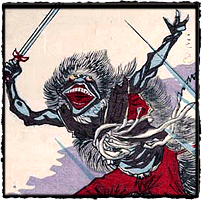 Contagious Disease
by Laura W. Allen
One-fifth
of the collection consists of prints related to contagious disease — smallpox,
cholera, or measles. Other themes in
the collection occur in several of these prints, such as those that depict the
influence of Shinto and Buddhist deities on disease, or promote traditional
Asian and Western remedies.
Smallpox
The UCSF collection
includes several rare printed talismans against smallpox, works known as hōsō-e (smallpox pictures) or aka-e (red pictures). Thought to have been made primarily to secure
recovery for children, the hōsō-e
are considered a type of ofuda, the
charms or talismans distributed by Shinto shrines. Attached to a door, post, or screen at the
victim's home, its purpose was to protect the inhabitants from the disease.
Though extremely popular in times of epidemic, the hōsō-e do not survive in great numbers, as in order to
fully banish the disease they were generally destroyed once the patient had
recovered.
Nihon shoki, Japan's
oldest historical text, records outbreaks of smallpox in Japan as early as 735. An early description of the disease is
included in the Ishinhō, a
medical text written in 984 by Tamba Yasuyori. Smallpox epidemics continued to
strike at regular intervals until the mid-nineteenth century, often with
devastating effects. In addition to high mortality rates, survivors could be
left blind, or at the very least badly disfigured by pockmarks. People were terrified of the disease, and
took comfort from whatever remedies or charms they thought might prove
effective in preventing or relieving its symptoms.
In Japanese, smallpox is
known as hōsō. Outbreaks of the disease and its spread
within the population were attributed to the activity of "noxious spirits,"
known as yakubyō-gami (plague
gods), hōsōgami (smallpox
gods), or tōki (pox
devils). The concept of the hōsōgami seems to have been somewhat
fluid, inasmuch as tutelary spirits, also known as hōsōgami, were called upon for protection from the
disease.
Many of the charms and
magical practices used in Japan
in connection with smallpox are red, as the color was believed to protect from
evil, and was especially attractive to the hōsōgami.
According to the Shōni hitsuyō
yōikugusa, published in 1798 by Kazuki Gyūan, "children suffering
from smallpox should wear red garments, and all those caring for the sick
should also wear red, as if the rash reddened, they would recover safely."
The belief that when the
smallpox rash turned from purplish to red, recovery was at hand, strengthened
faith in the color's magical properties.
A variety of minor deities, animals, and even toys associated with the
color red were recruited into the arsenal of folk beliefs rallied to prevent or
reduce the severity of smallpox symptoms.
The hōsō-e in the collection are instantly identifiable in
their reliance on a sole printed color, red.
Most prominent among the deities represented in hōsō-e are the many heroes associated with special
physical power and bravery:
Kintarō, a boy of amazing strength, who was raised in the Ashigara
mountains by his widowed mother, Yama-uba; Momotarō, the Peach Boy, whose
legend includes the vanquishing of demons on Onigashima (Demon Island);
Shōki, a Chinese general known as the "demon queller;" and the warrior
Minamoto no Tametomo (1139-1170).
The latter, a famous
archer, was exiled to the island of Hachijōjima following his role in the
Hōgen Revolt of 1156; it was said that while there he chased away the
smallpox god, keeping the island free from the disease.
The dual character of
the hōsōgami is clearly
revealed here. In some cases, powerful
heroes, themselves hōsōgami,
are shown shooing away, attacking, or killing other, malevolent spirits (also hōsōgami) who represent the
disease: the latter appear either as demonic beings or as ordinary humans
covered with the smallpox rash.
Other prints feature
benign, even lovable hōsōgami, who
may be solicited to hasten recovery: a
robust child, shown eating offerings such as dango (sweet rice balls) and rice with (red) adzuki beans, or
various children's toys, such as the harukoma
(hobby-horse) and hagoita
(battledore).
Thus the prints
incorporate both the notions of literally "fighting" a disease, as well as the
concepts of play and childlike amusements as a kind of magical antidote for
grave illness. Lightweight objects, like
the battledore, or the prints themselves, were also associated in folk beliefs
with limiting the severity of an illness, in the sense of a having a "light
case." Such images provided distraction
for sick children, while simultaneously embodying the parent's wish for full
recovery — a return to the child's original joyful and playful state.
|
|
|

